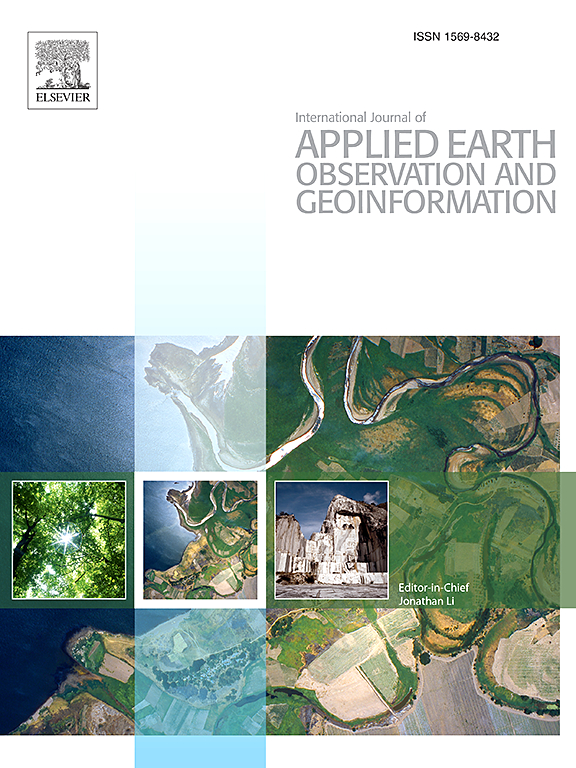通过本地到全球敏感特征融合网络进行地质遥感解译
IF 7.6
Q1 REMOTE SENSING
International journal of applied earth observation and geoinformation : ITC journal
Pub Date : 2024-11-22
DOI:10.1016/j.jag.2024.104258
引用次数: 0
摘要
解读地表地质要素(如岩石、矿物、土壤和水体)是地质调查的主要任务,在地质环境遥感(GERS)中起着至关重要的作用。然而,地质要素具有变异性大、形态多样、边界复杂、类分布不平衡等特点,使得深度学习方法在地质环境遥感图像判读中仍面临挑战。考虑到地质要素的相关性是地质统计学中的区域化变量,GERS判读的敏感特征主要包括三个方面:单类要素内部的色调、纹理和构造特征,相邻要素的空间和光谱相关性,以及其全球构造或空间分布。因此,为了模拟地质学家从局部到全局的人工解释过程,提高 GERS 解释性能,我们提出了局部到全局多尺度特征融合网络(LGMSFNet)。地质对象上下文表示同类像素集的类内语义依赖关系。而局部特征聚合模块则对通道和空间关联进行建模。然后,由全局特征融合模块整合判别特征。在模型优化方面,我们在训练过程中重点关注硬实例,以实现各种类别的均衡优化。我们选择了两个研究领域,包括大尺度岩石、土壤和暴露在地表的水。大量实验证明了 LGMSFNet 在 GERS 解译中的优越性。本文章由计算机程序翻译,如有差异,请以英文原文为准。
Geological remote sensing interpretation via a local-to-global sensitive feature fusion network
Interpreting surface geological elements (such as rocks, minerals, soils, and water bodies) is the main task of geological survey, which plays a crucial role in geological environment remote sensing (GERS). However, the characteristics of geological elements, including high variabilities, various morphology, complicated boundaries and imbalanced class distribution, make it still a challenge for deep learning methods to interpret GERS images. Considering the correlations of geological elements as the regionalized variables in geostatistics, the sensitive features of GERS interpretation mainly include three aspects: tonal, textural and structural characteristics within a singular-class elements, spatial and spectral correlations of adjacent elements, and their global tectonic or spatial distribution. Thus, to simulate the manual interpretation process of geologists from local to global and promote GERS interpretation performance, we propose a local-to-global multi-scale feature fusion network (LGMSFNet). A geological object context represents the intra-class semantic dependencies of pixel sets with the same class. And a local feature aggregation module models the channel and spatial association. Then discriminative features are integrated by a global feature fusion module. For the model optimization, we focus on hard examples during the training process to achieve the balanced optimization of various categories. Two research areas that include large-scale rocks, soils and water exposed on the surface are selected. Massive experiments demonstrate the superiority of the LGMSFNet in GERS interpretation.
求助全文
通过发布文献求助,成功后即可免费获取论文全文。
去求助
来源期刊

International journal of applied earth observation and geoinformation : ITC journal
Global and Planetary Change, Management, Monitoring, Policy and Law, Earth-Surface Processes, Computers in Earth Sciences
CiteScore
12.00
自引率
0.00%
发文量
0
审稿时长
77 days
期刊介绍:
The International Journal of Applied Earth Observation and Geoinformation publishes original papers that utilize earth observation data for natural resource and environmental inventory and management. These data primarily originate from remote sensing platforms, including satellites and aircraft, supplemented by surface and subsurface measurements. Addressing natural resources such as forests, agricultural land, soils, and water, as well as environmental concerns like biodiversity, land degradation, and hazards, the journal explores conceptual and data-driven approaches. It covers geoinformation themes like capturing, databasing, visualization, interpretation, data quality, and spatial uncertainty.
 求助内容:
求助内容: 应助结果提醒方式:
应助结果提醒方式:


